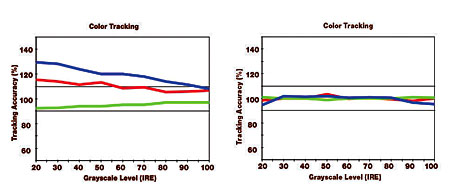Toshiba REGZA 46SV670U LCD HDTV HT Labs Measures
Black: 0.000
White: 25.59
Full-On/Full-Off Contrast Ratio: Unmeasurable
All of the measurements here, unless noted otherwise, were taken in the Movie mode, through an HDMI input, with the set adjusted as needed for the most accurate picture in a darkened room.
While the numbers here suggest an infinite full-on/full-off contrast ratio, in practice it’s only infinite because the black level with DynaLight either shuts down completely or is too low to measure with our test tools. However, this is a superb result.
With DynaLight off, the peak contrast ratio decreased to 1,982:1 (29.73 foot-lamberts peak white, 0.015 ft-L black). With DynaLight on, the back-light raised to 100, and the other settings unchanged, the black level increased to a barely measurable 0.001 ft-L and the peak white to 61.71, for a peak contrast ratio of 61,710:1. When you turn DynaLight off at this backlight setting, the peak contrast ratio decreases to 2,062:1 (74.23 ft-L peak white, 0.036 ft-L black). The minimum specified sensitivity of our Minolta LS-100 light meter is 0.001 ft-L, and it’s likely on the ragged edge of accuracy at this low level. Still, the results show that with DynaLight engaged, increases in the backlight setting don’t seriously compromise the black level.

The Toshiba’s color tracking out of the box was poor, and even the lowest setting of the Color Temperature control (0) produced a color temperature of around 7000K. This improved significantly after calibration, but I couldn’t completely remove a greenish shift at very low brightness levels (below 20 IRE). The start of this trend is barely visible on the After Calibration chart below. However, the visible effect of this deviation was minimal on normal program material. The Toshiba’s post-calibration Delta E numbers, while not among the best we have measured, increased beyond 4 only at the darkest accurately measurable brightness level (5.4 at 20 IRE) and at peak white (4.5 at 100 IRE).

The Toshiba’s factory color gamut had oversaturated greens. The color management system (ColorMaster) offers a full range of color gamut control, but it couldn’t correct the gamut without distorting the color decoding. Most HDMI sources arrive at a display as digital component, or Y/Cb/Cr. The set must convert this to RGB, and if this conversion is incorrect, the colors will be wrong. I preferred to get the color decoding right and let the color gamut fall where it may. In the end, I left the ColorMaster controls at their factory defaults. This is the result shown in the CIE diagram above.
One ergonomic annoyance was that neither the Color Temperature nor the ColorMaster controls, once selected, remained out of the way at the bottom of the screen long enough to measure their effects with a precision meter. Long before that, a full-screen menu pops back up, which invalidates the reading.—TJN





























































